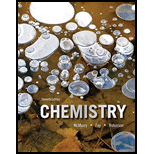
Interpretation:
The heat of vaporization of nitrous oxide in
Concept introduction:
Nitrous oxide is a secure and efficient narcotic agent which is mixed with oxygen and breathed in via a tiny mask which fits over your nose to assist you relax.
Nitrous oxide, in some cases called “laughing gas,” is single alternative your dental specialist might suggest to assist and make you extra comfortable through certain procedures. It is not aiming to put you to doze.
The vaporization curves of major liquids have same shapes. The vapor pressure consistently increments as the temperature increments. A better method is to discover the mathematical approach for the increment in pressure as a function of temperature. experiments appeared that the temperature T and vapor pressure P are connected,
Here,
R = constant
So, if we assume that, P1 as well as P2are the vapor pressures at two temperatures T1 and T2, then we can find a below simple connection
This is recognized as the Clausius-Clapeyron Equation and permits us to assess the vapor pressure at a different temperature, if the vapor pressure is identified at certain temperature, and if an enthalpy of vaporization is identified.
Want to see the full answer?
Check out a sample textbook solution
Chapter 11 Solutions
Chemistry
 ChemistryChemistryISBN:9781305957404Author:Steven S. Zumdahl, Susan A. Zumdahl, Donald J. DeCostePublisher:Cengage Learning
ChemistryChemistryISBN:9781305957404Author:Steven S. Zumdahl, Susan A. Zumdahl, Donald J. DeCostePublisher:Cengage Learning ChemistryChemistryISBN:9781259911156Author:Raymond Chang Dr., Jason Overby ProfessorPublisher:McGraw-Hill Education
ChemistryChemistryISBN:9781259911156Author:Raymond Chang Dr., Jason Overby ProfessorPublisher:McGraw-Hill Education Principles of Instrumental AnalysisChemistryISBN:9781305577213Author:Douglas A. Skoog, F. James Holler, Stanley R. CrouchPublisher:Cengage Learning
Principles of Instrumental AnalysisChemistryISBN:9781305577213Author:Douglas A. Skoog, F. James Holler, Stanley R. CrouchPublisher:Cengage Learning Organic ChemistryChemistryISBN:9780078021558Author:Janice Gorzynski Smith Dr.Publisher:McGraw-Hill Education
Organic ChemistryChemistryISBN:9780078021558Author:Janice Gorzynski Smith Dr.Publisher:McGraw-Hill Education Chemistry: Principles and ReactionsChemistryISBN:9781305079373Author:William L. Masterton, Cecile N. HurleyPublisher:Cengage Learning
Chemistry: Principles and ReactionsChemistryISBN:9781305079373Author:William L. Masterton, Cecile N. HurleyPublisher:Cengage Learning Elementary Principles of Chemical Processes, Bind...ChemistryISBN:9781118431221Author:Richard M. Felder, Ronald W. Rousseau, Lisa G. BullardPublisher:WILEY
Elementary Principles of Chemical Processes, Bind...ChemistryISBN:9781118431221Author:Richard M. Felder, Ronald W. Rousseau, Lisa G. BullardPublisher:WILEY





